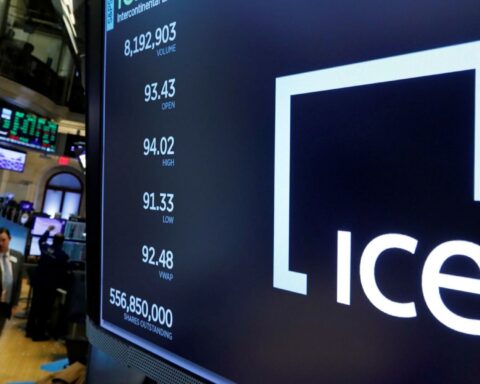AMSTERDAM & LONDON & NEW YORK– Intercontinental Exchange (NYSE:ICE), a leading global provider of data, technology, and market infrastructure, today announced that a record volume of environmental contracts traded in 2021. A total of 18 billion tons of carbon allowances traded in 2021, equivalent to an estimated $1 trillion in notional value and equal to over half the world’s estimated total annual energy-related emissions footprint.
Reflecting how companies use these markets to manage and price climate risk, as well as meet compliance obligations, a record 19 million environmental futures and options contracts traded on ICE in 2021. These traded contracts included a record 15.2 billion EU carbon allowances, a record 2.4 billion California carbon allowances, 346 million Regional Greenhouse Gas Initiative allowances and, following its launch in May 2021, 255 million U.K. carbon allowances.
“For over a decade, ICE has provided the markets with the ability to price the negative externality of emissions through carbon allowance futures, and the positive externality of creating carbon-free electricity through renewable energy certificate (REC) futures,” said Gordon Bennett, Managing Director of Utility Markets at ICE. “This year we will be expanding our carbon credit markets to value and support the preservation of natural assets, as well as launching our first carbon index futures contract to provide access to the global cost of emissions in one instrument.”
In October 2021, ICE invested in LevelTen Energy, which brings greater transparency and liquidity to the renewable energy industry and enables participants to transact on power purchase agreements and physical energy assets more efficiently. In addition, ICE plans to expand its renewable energy futures markets with the launch of six new U.S. REC futures on January 18, based on solar and wind energy. U.S. REC markets are among the most liquid and transparent green certificates available. Approximately 705,000 REC futures traded on ICE in 2021, equivalent to an estimated 48 million megawatt hours of renewable energy or enough to power around 4.5 million homes for a year.
“The widespread electrification of the energy system and a transition to a cleaner grid will become key themes in meeting net zero targets,” continued Gordon Bennett. “We are seeing significant demand from corporate buyers who want to green their power consumption through renewable power purchase agreements and renewable energy certificates. REC futures markets will become increasingly important to the process of efficiently allocating capital to renewable electricity projects and managing the risks of transitioning to a cleaner electricity grid.”
ICE plans to launch its first financially settled global carbon futures contract (ICE: CO2) based on the ICE Global Carbon Futures Index on January 31, 2022. In addition, ICE is working to launch several initiatives in 2022 to further support the development of carbon credit markets globally. This includes launching ICE’s first Nature-Based Solutions futures contract, subject to regulatory approval; its first carbon credit auctions for Permian Global, a developer of large-scale tropical forest protection and restoration projects; and forming the ICE Carbon Oversight Committee to provide independent governance and oversight of ICE’s activities in the voluntary carbon markets.
ICE offers customers access to the largest and most liquid environmental markets in the world to price climate risk.






